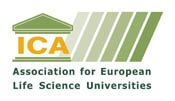9th CASEE Conference - Session 2
Session 2: Renewable resources – possibilities and constraints (including forests and biotechnology)
Chairs:
Prof. dr Florian Borlea, BUASVMT, Romania
Acad. prof. dr. Doru C. Pamfil, University of Agricultural Sciences and Veterinary Medicine Cluj-Napoca, Romania
The section included presentations (7 oral presentations) and poster sessions from universities from six countries. Renewable resources are very much used as raw materials for a broad range of end products as well as for renewable energy production all over the world, including Central and South-Eastern Europe, in competition with other natural resources or different materials and products. The presentations belonged to very various topics. The main topics of the section 2 were: Renewable energy, Biotechnology and Forestry. The presentations showed how important renewable energy (photovoltaics) constraints can be avoided: the constant electricity supply to the grid and the critical grid loads. The case study of using a battery-type electric energy storage for a decentralized photovoltaic and electric energy storage systems for autonomus buildings in Austria was presented and discussed as visionary prospective for the future when the share for renewable energy will increase and will be a higher demand to balance the demand and supply.
Another important topic was Biotechnology and the screening of microorganisms displaying acetyl xylan esterase activiy was presented as important development in the field. Another presentation was about one of the most abundant natural polymer: hemicellulose – a major component of lignocellulose biomass located between lignin and cellulose fibers and considered the second most abundant natural polymer on earth. Its main constituent is xylan. Four mutant tested strains displaying the highest acetyl xylan esterase activities were identified and the best acetyl xylan esterase activity was detected. The preliminary testing of SRAP primers in four Ranunculaceae species from Romania, was performed in order to provide fundaments for their conservation strategies. Biodiversity is essential for natural pest control and in this respect tests to identify the most efficient/representative SRAP marker combinations of the Ranunculaceae tested species were performed. The results have highly contributed to perform future genetic diversity analyses; in situ and ex-situ conservation perspective.
Forestry is a very challenging domain in Central and Eastern Europe. A comparison between pristine-pure stand and a mixed beech-oak stand using unmanned aerial vehicle was presented. The complex diversity in natural forest was revealed using unmanned aerial vehicle: canopy cover, upper layer tree crowns and canopy gaps in an managed old mixed beech with oak stand and a pristine pure-beech stand in order to compare them. The natural forest had two times more gaps and crowns/ha compared to the managed forest. Percentage Canopy Cover (PCC) represents the proportion of the ground covered by the vertical projection of the tree crowns [Jennings et al, 1999] and the PCC difference between the natural forest compared to the managed forest is 7 %. The managed forest tree shapes are similar to those in natural forest based on mean Gap shape complexity index (GSCI). This should indicate that species richness level is above normal in this forest. The forest management activities is the cause of the regularly distributed patterns of canopy gaps and trees. The oak species are an important forest resource able to provide renewable and sustainable materials, enriching the ecosystems services and fulfilling the social demands in Western Romania. The important role of environmental factors for wood quality was presented. The relation between oak wood value sortiments and local conditions was studied analyzing the results from the wood auctions in 6 forest districts from Western Romania in the period 2003-2017. The volumes of harvested wood (m3)/sortiments and their sale price series in euro/m3 in each site type were presented.
In conlcusion, the use of renewable resources is challenging in the present-day context of climate change and global changes in general. New strategies and innitiatives at global, european or local level are promoting their use but the decision on utilisation renewable resources is taken in general within a technical, economical-finnancial as well as regulatory and cultural framework.
Possibilities are unlimited because:
- they are „living” resources and can be managed in a sustainable way.
- they are renewable but also environmentally-friendly,
- they are based on natural diversity
Constraints are sometimes high because of the competition on use (ex. of wood biomass: energy versus other industries), land-use problems and because of their sensitive relation with biodiversity and environment.
Presentations:
- Magdalena Wolf - Decentralized photovoltaic and electric energy storage systems for autonomous buildings and seasonal base load provision to the grid
- Aglaia Burlacu - Screening of microorganisms displaying acetyl xylan esterase activityAglaia Burlacu - Screening of microorganisms displaying acetyl xylan esterase activity
- Cristina Daniela Kelemen - Preliminary testing of SRAP primers in order to establish genetic diversity of four Ranunculaceae species from Romania
- Tiberiu-Paul Banu - Comparison between pristine pure-beech stand and mixed beech-oak stand using an unmanned aerial vehicle
- Cristina Daniela Kelemen - In vitro antioxidant and anti-proliferative activity of Ranunculaceae species from Romania
- Adrian Oprea - Oak species - providing renewable and sustainable raw materials, enriching the ecosystems services and fulfilling the social demands. Case-study - Western RomaniaAdrian Oprea - Oak species - providing renewable and sustainable raw materials, enriching the ecosystems services and fulfilling the social demands. Case-study - Western Romania
- Marius-Ion Manea - Challenges regarding the recent evolution of native lime tree species in the managed forests of Caransebes area, Western Romania



